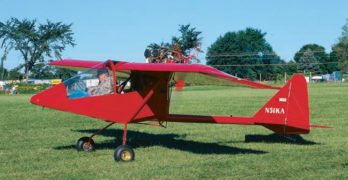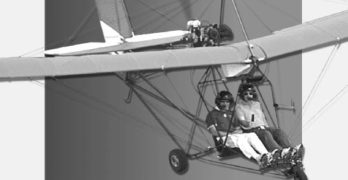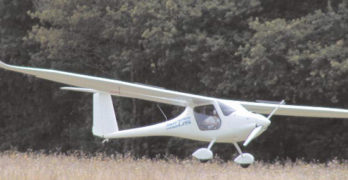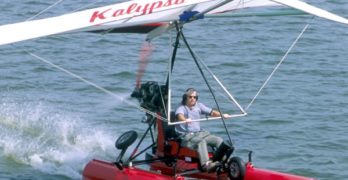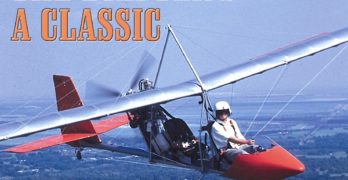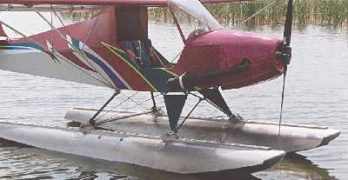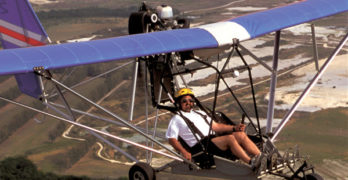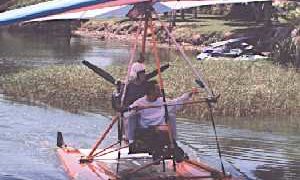FACING THE BUYING DECISION, PART II
Last time we discussed the pilot (you!); this time we discuss the many types of aircraft choices you have. In the last installment, we’ll put these together and help you narrow your choices to a few models.
What Kind of Pilot Are You?
Let’s just say you actually know yourself. While this sounds like a comment that deserves a “Duh!” response, don’t be too quick to judge. If every pilot or buyer of aircraft knew what they needed or wanted, my job would be easier. But it isn’t so. Most pilots know something about what they want, but many don’t have enough information to make the best decision.
Some readers are “experts.” A good many ultralight or light plane enthusiasts have been around long enough and owned enough variety of ultralights to know what they like.
These veteran sport aviators represent a lot of combined experience.
Search Results for : floatplane
Not finding exactly what you expected? Try our advanced search option.
Select a manufacturer to go straight to all our content about that manufacturer.
Select an aircraft model to go straight to all our content about that model.
How-to-Buy a Lightplane — Part 1 of 3
WANT TO BUY A LIGHTPLANE?
Task Can Be Daunting, Yet Rewarding
I’m one lucky pilot. I love airplanes and get to fly more of them than the average sky jockey. Writing pilot reports for several magazines has given me the opportunity to fly about 250 different aircraft in the last 23 years.
This makes me a “Master of None” type of pilot (except in my own planes) but does give me a feel for the huge variety of light airplanes you can buy.
The choices are fantastic. Counting the whole world of sport aircraft, you can have just about anything you want| and that’s the problem. What to buy?
TRYING TO HELP
At every airshow I attend, and through phone calls between airshow, pilots often make a request: “You’ve flown all these lightplanes, which one should I buy?”
Frankly, the question makes me uncomfortable.
While I appreciate the feeling of confidence some pilots place in my experience, telling someone what to buy is a sure way to be considered wrong eventually.
Antares MA-32 on Floats
A Trip to Alaska Unearthed a Hotbed of Ultralight Activity.
Alaska’s facts are amazing. Most everyone knows that the sun stays up incredibly late-in the northern oil fields of Prudhoe Bay it doesn’t set for three months! But did you also know the daily tidal change amounts to a whopping 38 feet?
More on point for an aviation magazine, Alaska boasts the highest concentration of pilots anywhere in the U.S. and probably the world. While the lower 48 states contain about one pilot in 500 among the general population, Alaska has one in 47. Even more astonishing is airplane ownership. One out of every 53 residents owns an airplane. In the contiguous United States, that figure is closer to one in 1400.
In Alaska, nobody complains about airplane noise. No wonder-with a physical size about half of the contiguous U.S., the state has only 13 highways, three of which are gravel.
Europe Embraces Light-Sport Aircraft
Many excellent aircraft may be headed our way
Parlez-vous Française? Sprechen Sie Deutsche? Parlate Italiano? Fortunately, to understand European recreational aircraft you don’t need to speak French, German, or Italian. Yet the light-sport aircraft (LSA) that may interest you could come from countries where the mother tongue isn’t English.
Welcome to the globalized
world of light-sport
aircraft where the workers
who built your plane may speak
Polish, Russian, Hungarian, or
Latvian in addition to French,
German, or Italian.
Though many intriguing
ultralights come from Europe and
Americans have seen a few of these,
many are a complete surprise to
Yankee pilots. That will change.
Last year after EAA AirVenture
Oshkosh 2002 ended, I traveled to
Blois (pronounced Blwah), France, a
town about 200 kilometers south of
Paris. There I attended the 22nd
salon (or air show) that organizers
present at this location each year in
late summer. Let’s take a walk
around the salon at Blois.
Efficient Amphib Trike; The Kalypso
My computer dictionary says Calypso is “A sea nymph who delayed Odysseus on her island for 7 years.” It is also the name of one of Saturn’s moons, a flower, and a West Indian musical style. Any of these meanings infer a pleasant experience, a sensation sure to be duplicated by the ultralight amphibious Kalypso (spelled with a “K”) with its Krücker-designed floats.
I don’t know if the Kalypso is enough to keep you stuck on an island for 7 years, but I found her to be a most desirable ultralight.
Take It Home with You
Trikes are highly mobile aircraft. One reason they became so popular in Europe and even here in the roomier US of A is that they break down easily. You can carry a trike in a pickup truck – with the right hardware added to properly support chassis and wing. Or you can use a small trailer and carry the wing on your car or truck.
Super Drifter
The original Drifter was one of the ultralight industry’s flagship aircraft. Hatched by early entrepreneur Dennis Franklin, the Maxair Drifter enjoyed immense popularity. Several reasons exist for the Drifter’s popularity, and these were enough for Leza-Lockwood to offer a rebirth to the design.
Déjà Vu All Over Again
The Drifter is a tough design. The basic airframe consists of a lower boom tube that supports the pilot at the front and the large empennage at the rear with an engine midship. Because the separation is longer than some similar designs, the Drifter boasts a high level of stability that should please most pilots.
Secured to the boom by a series of triangulated tubing structures, the wing is classic Klaus Hill. This prolific designer from the early ’80s died in an unfortunate accident many years ago, but not before putting his indelible mark all over ultralight aviation. Klaus is directly responsible for the wings of the Weedhopper, Hummer, Humbug and SuperFloater.
Flying Sky Raider
Since Flying K Enterprises’ Sky Raider arrived on the scene 4 years ago, the ultralight design has achieved excellent success in the market selling more than 140 kits (not including the 65 or so fuselages shipped to SkyStar Aircraft which they use for their Kitfox Lite). However, the company behind the Sky Raider design has suffered in nontechnical ways.
Original Flying K principals brothers Ken and Stace Schraeder split up and started separate companies making ultralights. Then, only months after the split, Ken Schraeder was killed while flying a Sky Raider (see “Flightlines – Kenny Schraeder Killed in Crash,” April ’00 Ultralight Flying! magazine).
Despite these setbacks, the Sky Raider flies onward. In fact, Flying K Enterprises seems to be healthy and energetic despite the twin losses.
When the company shows their Sky Raider floatplane model and an example of their coming 2-seater, crowds often flock around the ultralights. I was full of anticipation to see how the floatplane would fly.
M Squared’s Breese 2
Customers spoke and M-Squared acted. This proves the marketplace works, where customers “vote” with every dollar spent to acquire certain products. More importantly to pilots, this fact explains why a review of M-Squared’s new 2-seater – the Breese 2 – is good for customers.
Customers liked what M-Squared was doing. The 1996 company startup took a popular Quicksilver airframe design, added struts and beefed up the airframe to accept engines as large as the 100-hp Rotax 912S. But pilots also liked the way the original Quicksilvers (which are lighter) flew and handled. Being in business to serve customers, M-Squared acted appropriately.
Paul Mather and M-Squared responded to requests for a lighter version of their 2-seat Sport 1000 in a series of steps. First came the single-surface wing Sprint 1000, which dropped a few pounds by not using the big pod of the first Sport 1000. Then came the Breese SS (single-surface) and Breese DS (double-surface) single-seaters, which were obviously lighter and more agile.
Facing the buying decision
What Kind of Pilot Are You?
Let’s just say you actually know yourself. While this sounds like a comment that deserves a “duh!” response, don’t be too quick to judge. If every pilot or buyer of an aircraft knew what he/she needed or wanted, my job would be easier. But it isn’t so. Most pilots know something about what they want, but many don’t have enough information to make the best decision.
Some readers are “experts.” A good many ultralight or light plane enthusiasts have been around long enough and owned enough of a variety of ultralights to know what they like. These veteran sport aviators represent a lot of combined experience. If you’re new to ultralight flying, I strongly encourage you to seek out local experts. They can be your very best source of information because they know you. (However, as I reminded you last time, remember that anybody selling any aircraft – whether their own or one they represent – has a bias that you must not overlook.
Buggy on Floats
Float-Equipped Air Création Trike
Trikes and floats offer the same fun potential as do floats on most ultralights. But they offer more challenge to make it work.
First of all, trikes leave the ground differently than most 3-axis ultralights. When the wing takes off, the chassis swings into place underneath it, pivoting forward several inches of displacement. While this makes landings easy (the main gear contacts earth first), this shift requires float fitting to be well-considered.
Then, you must develop a water rudder system, which isn’t particularly challenging except to keep everything light. Without such a system, a trike cannot be maneuvered in the water, unlike a rudder airplane which can steer by propblast against the rudder. The standard steering pedals are used in the same push- right go-left method of ground steering a trike.
I once tried to water taxi a trike (for a photo shoot of all things) back in the early ’80s, before water rudders had been developed for trikes.
- « Previous Page
- 1
- …
- 6
- 7
- 8


